
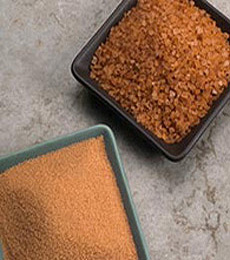
Beautiful alaea sea salt from Hawaii. Photo courtesy of Saltworks.us.
September 2005
Last Updated September 2025
|
 |
Different Types Of Salt: A Culinary Salt Glossary
Fine Sea Salts & Artisan Salt From All Over The World
Page 1: Alaea (Hawaiian Sea Salt), Anglesey & Other Salts With A & B
Overview
Master the terms in this glossary, and you’ll be able to use “salty” language with the experts. You’ll also discover delicious new salts to flavor your food and decorate your plates. We’ve provided an overview of some of the more readily found sea salts and artisan salts. The category is burgeoning, and every geographic area from the Cayman Islands to Africa is offering up a sea salt.
While any sea salt is going to be tastier than supermarket table salt, it’s also much pricier. Just like “wine,” the label “sea salt” doesn’t mean the product is an outstanding sea salt. Any evaporated seawater will produce sea salt: It’s the particular mineral content and quality of the water that makes a great sea salt. For your first foray into the category, you might get a better handle on sea salt by sticking to some of the standards. A good “starter kit” would be one of the great French salts, Fleur de Sel de Guérande or sel gris; a flake salt like Anglesey, Maldon or the pink Murray River salt; a smoked salt; and if you love to present with flair, alaea red volcanic salt and one of the black salts from Cyprus or Hawaii. For an extensive selection of fine sea salts and artisan salts, visit Saltworks.us.
This is Page 1 of a seven-page glossary. After you’ve read up on sea salt, take a look at our other food glossaries—more than 100—an easy way to get up to speed on almost every food category.
Defining Tiny Measurements
Yes, there are definitions for these measures of salt. This is how they’re used by professional chefs:
- Pinch: 1/16 teaspoon
- Dash: 1/8 teaspoon
- Tad: 1/4 teaspoon
Click on a letter to get to the appropriate glossary page.
a b c d e f g h i j k l m n o p q r s t u v w x y z
This glossary is protected by copyright and cannot be reproduced
in whole or in part. You are welcome to link to it.
ALAEA or ALAE or HAWAIIAN SEA SALT or RED VOLCANIC SALT
A Hawaiian sea salt, alaea takes its name from the area’s red volcanic clay, which gives it a beautiful terra cotta color. On the island of what is now Kauai, the sediment of iron oxide-rich red volcanic clay, called alaea, seeped into the ocean from Kauai’s rivers. When this red ocean water became trapped in tidal pools, evaporation created alaea sea salt. The clay imparts a delicate, earthy, mineral flavor that is more mellow than regular salt. It can be saltier, too. Alaea adds a subtle crunch to dishes and can be purchased mixed with herbs for use on fish. Alaea, kala namak (Indian black salt), and sel gris are considered to be the most mineral-rich salts. A traditional seasoning in Hawaiian dishes, it can be used elsewhere in pork dishes, fish, prime rib, and as a colorful accent on corn and potatoes.
|
|
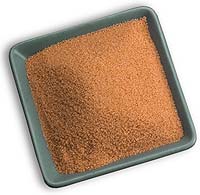
Finely-ground alaea. Photo courtesy of SaltWorks.us. |
AMERICAN SEA SALT
Not to be confused with fine natural sea salts, American sea salts, often found in grocery and healthy food stores, are manufactured products that have been totally refined until they are no better than sodium chloride—ordinary table salt. Yet, because they originally derived from seawater, they can be labeled sea salt. It is because they are harvested from general seawater, not pristine sources like those of fine natural sea salts, that refining, bleaching, and additives are required.
ANGLESEY or HALEN MÔN
Sea salt from the water off the west coast of Wales, where it is freshly harvested from the Atlantic waters that surround the Isle of Anglesey. Anglesey has a soft, flaky texture. By itself, this can be extremely salty, especially in large flakes of salt. The salt is also available smoked over 800-year-old Welsh oak chips, producing a Champagne-colored flake with a delicate smokiness. Salt sold under the Halen Môn brand is from Anglesey; There is only one sea salt company on Anglesey. The brand name is Halen Môn, which is the Welsh translation of “Anglesey Salt.” Crunchy in texture, it is also available in a spiced form with nine organic spices, including coriander, cumin, turmeric, paprika, chili, cinnamon, cloves, ginger, nutmeg, and peppercorns.
|
|
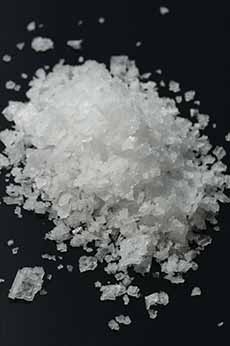
Smoked Anglesey salt (photo by River Soma © The Nibble). |
ARTISAN SALT
A salt that is produced more extensively than by the simple evaporation of seawater. These include smoked salts and sea salts that are created in solar houses rather than evaporated naturally outdoors in evaporation ponds, basins or pans. Artisan techniques are popular in countries like Japan where where high humidity and/or frequent rainstorms preclude efficient natural evaporation.
BLACK SALT
Black salt refers to a variety of unrefined sea salts that range from dark grey to black in color. Two of the best-known are Hawaiian volcanic sea salt (a.k.a. black lava salt) and Cyprus black sea salt. The term also refers to Indian black salt, or kala namak, which is actually pink or pinkish-brown rock salt.
Hawaiian black flake salt, also called black lava salt, is a sea salt harvested from the Pacific Ocean surrounding the Hawaiian islands and blended with activated charcoal derived from coconut shells. This gives the salt its distinct black color.
Cyprus black flake salt, harvested from the Mediterranean Sea off the coast of Cyprus, is unique and exotic, with large black pyramid-shaped flakes that provide lots of crunch.
The sea salt is processed with carbon, which is obtained from naturally processed charcoal from soft woods such as birch, linden, and willow.
Kala namak, Indian black salt, is more complex in flavor than the other black salts. Made from crushed Indian volcanic rock salt, it consists of primarily sodium chloride, plus trace impurities of sodium sulfate, sodium bisulfate, sodium bisulfite, sodium sulfide, iron sulfide, and hydrogen sulfide.
Sodium chloride provides a salty taste, iron sulfide provides a dark violet hue, and all the sulfur compounds give it a slightly savory taste as well as a highly distinctive aroma, with hydrogen sulfide being the most prominent contributor to the latter. The acidic bisulfates/bisulfites contribute a mildly sour taste.
|
|
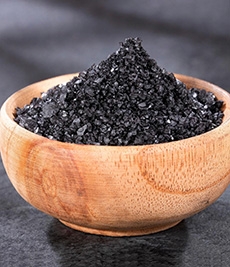
Black sea salt (photo © Get Flavor).
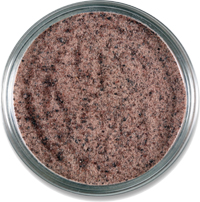
Kala namak. (photo © SaltWorks).
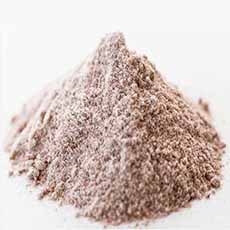
A lighter shade of kala namak. (photo © Pachaa).
|
BAMBOO SALT or PARCHED SALT or JUKYOM or JOOK YEOM or KOREAN BAMBOO SALT
Jugyeom, also known as bamboo salt, is a Korean specialty. It is prepared by packing bay salt from the west coast of Korea in a thick bamboo cylinder (stem), plugged with yellow mud. The cylinder is then baked nine times at a high temperature using pine firewood. The salt absorbs minerals from the bamboo and mud, which in turn leach the salt of impurities (the distinctive sweetness imparted by the bamboo is known as gamrojung flavor). The baked salt lumps harden after baking and are taken out, crushed, and repacked in the bamboo stem for the next cycle of baking. Baking darkens the white salt. The ninth baking process uses the highest temperature, over 1,000°C (1,830°F). Afterwards, the bamboo salt looks purple. Owing to the labor, the salt is pricey. Sea salt can be substituted in recipes.
Hawaiian Bamboo Salt is a different kind of bamboo salt. Pacific sea salt that (like all sea salt) contains naturally occurring mineral electrolytes and trace minerals is evaporated and then infused with bamboo leaf extract. The extract imparts a fresh green color and delicate flavor. The salt is used in Asian recipes, including stir-fries. In American cuisine, it can be used as a finishing salt to garnish beef, chicken, pork, soup, white fish, and salmon.
|
|
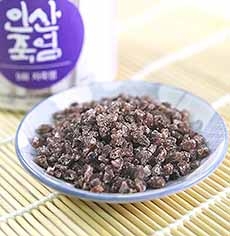
Bamboo salt (photo © Insam Store | Amazon).
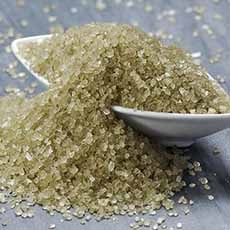
Hawaiian green bamboo salt (photo © Gourmet Food Store). |
BLENDED SALT
Salt that is mixed with other flavorings like herbs, berries, or seaweed. As opposed to seasoned salt, which mixes different everyday seasonings with the salt for convenience, blended salts are more gourmet in concept.
Continue To Page 2: Salt Terms Beginning With Letter C ~ E
Go To The Article Index Above

|









